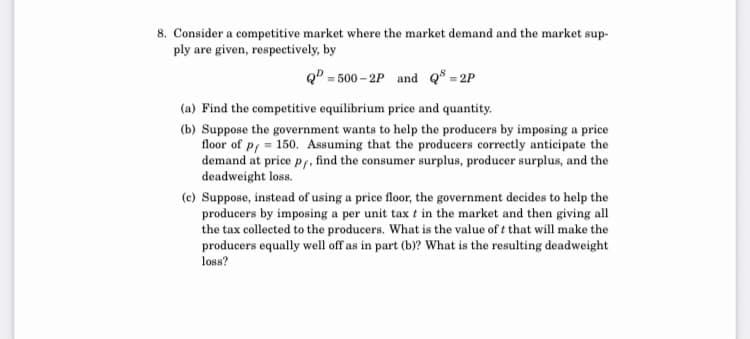8. Consider a competitive market where the market demand and the market sup- ply are given, respectively, by Q" = 500 - 2P and Q* = 2P (a) Find the competitive equilibrium price and quantity. (b) Suppose the government wants to help the producers by imposing a price floor of p, = 150. Assuming that the producers correctly anticipate the demand at price pr, find the consumer surplus, producer surplus, and the deadweight loss.
8. Consider a competitive market where the market demand and the market sup- ply are given, respectively, by Q" = 500 - 2P and Q* = 2P (a) Find the competitive equilibrium price and quantity. (b) Suppose the government wants to help the producers by imposing a price floor of p, = 150. Assuming that the producers correctly anticipate the demand at price pr, find the consumer surplus, producer surplus, and the deadweight loss.
Principles of Economics (MindTap Course List)
8th Edition
ISBN:9781305585126
Author:N. Gregory Mankiw
Publisher:N. Gregory Mankiw
Chapter7: Consumers, Producers, And The Efficiency Of Markets
Section: Chapter Questions
Problem 6PA
Related questions
Question
100%

Transcribed Image Text:8. Consider a competitive market where the market demand and the market sup-
ply are given, respectively, by
QD = 500 – 2P and Q³ = 2P
(a) Find the competitive equilibrium price and quantity.
(b) Suppose the government wants to help the producers by imposing a price
floor of pf = 150. Assuming that the producers correctly anticipate the
demand at price p,, find the consumer surplus, producer surplus, and the
deadweight loss.
(c) Suppose, instead of using a price floor, the government decides to help the
producers by imposing a per unit tax t in the market and then giving all
the tax collected to the producers. What is the value of t that will make the
producers equally well off as in part (b)? What is the resulting deadweight
loss?
Expert Solution
This question has been solved!
Explore an expertly crafted, step-by-step solution for a thorough understanding of key concepts.
Step by step
Solved in 3 steps with 2 images

Knowledge Booster
Learn more about
Need a deep-dive on the concept behind this application? Look no further. Learn more about this topic, economics and related others by exploring similar questions and additional content below.Recommended textbooks for you

Principles of Economics (MindTap Course List)
Economics
ISBN:
9781305585126
Author:
N. Gregory Mankiw
Publisher:
Cengage Learning

Principles of Microeconomics (MindTap Course List)
Economics
ISBN:
9781305971493
Author:
N. Gregory Mankiw
Publisher:
Cengage Learning

Principles of Macroeconomics (MindTap Course List)
Economics
ISBN:
9781285165912
Author:
N. Gregory Mankiw
Publisher:
Cengage Learning

Principles of Economics (MindTap Course List)
Economics
ISBN:
9781305585126
Author:
N. Gregory Mankiw
Publisher:
Cengage Learning

Principles of Microeconomics (MindTap Course List)
Economics
ISBN:
9781305971493
Author:
N. Gregory Mankiw
Publisher:
Cengage Learning

Principles of Macroeconomics (MindTap Course List)
Economics
ISBN:
9781285165912
Author:
N. Gregory Mankiw
Publisher:
Cengage Learning

Essentials of Economics (MindTap Course List)
Economics
ISBN:
9781337091992
Author:
N. Gregory Mankiw
Publisher:
Cengage Learning

Principles of Economics, 7th Edition (MindTap Cou…
Economics
ISBN:
9781285165875
Author:
N. Gregory Mankiw
Publisher:
Cengage Learning

Principles of Microeconomics
Economics
ISBN:
9781305156050
Author:
N. Gregory Mankiw
Publisher:
Cengage Learning